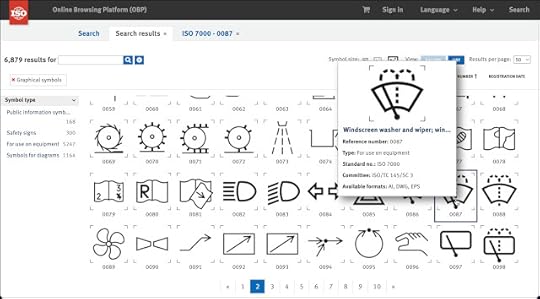Answer: What do these everyday symbols mean?
Symbol recognition...
 P/C Dan.
P/C Dan.... usually happens unconsciously, or at least very rapidly.
Our world is full of symbols that we see, yet might not really understand. Here are a few such symbols... what are they? What do they mean? (And most importantly, HOW DID YOU LEARN what they are?)
Let's answer this week's Challenges.
1. What's this symbol? What does it mean? Where might you see this?
As a few people pointed out, these Challenges aren't that difficult. This one is especially easy: you just copy the symbol and then paste into your search engine. When I paste this character into Google I see this:


And clicking on the Wikipedia link shows you this:
 Fleuron Wikipedia page
Fleuron Wikipedia pageNotice that the highlighted text is the same text that's extracted into the "People also ask" abstract. VERY handy.
Answer: This is the "Rotated floral heart bullet emoji" aka the "floral heart" or "hedera" or "aldus leaf."
(I note in passing that Bing doesn't have anything for this query.)
2. What's this symbol? What does it mean? Where might you see this?

Again, this isn't tough... just right click (or Control+click on a Mac) to search for Image with Google. (Or, if you're old school, you can save the image to your drive and then do a regular reverse image search.)
But you'll quickly learn that this is the OBA icon. Okay, what's that?
The obvious search teaches us that this the "Online Behavioral Advertising" icon indicating that the website follows the AdChoices design guidelines.
AdChoices is a self-regulatory program for online interest-based advertising in the United States, Canada, and Europe.
The idea is that clicking the icon "...provides information from the company that helped bring you the ad and [gives you] a choice to opt out from such interest-based ads using free-to-the-consumer Digital Advertising Alliance (DAA) tools." (Link to YourAdChoices.com and the Wikipedia article on AdChoices.)
That might be, but until recently, I never really noticed it--I certainly didn't think of it as a clickable target on the page. Did you? (Just for fun, I finally clicked on one of these icons... it was supremely unhelpful in helping me manage my ads preferences.)
Answer: This is the OBA icon that, in principle, will help you manage the ads that are shown to you. In practice, it's not especially helpful.
3. What are these symbols? What do they mean? Where might you see these? What's the difference between the two symbols?


Search-by-image is our friend again, but it takes a little more digging to realize that these Power On/Off icons represent two VERY different ways of turning a gadget on-and-off. From the image search I found the Wikipedia article about the different Power Symbols that are in use.
The top symbol (vertical bar completely enclosed in a circle) means that this switch turns the power fully ON or fully OFF. (per IEC 60417-5010)
By contrast, the other power symbol (incomplete circle with vertical bar emerging) means that the power system indicates that the switch turns on a sleep mode or low power state. The switch does not fully disconnect the device from its power supply. (per IEC 60417-5009)
Why does this matter? When power is fully-off, the device consumes no power at all. As you know, many household devices (TVs, computers, etc.) have a low-power mode, also known as "phantom" or "vampire" power mode. Something like 25% of household electricity is spent on this low-power mode. (David Pogue, NYTimes)
I learned this the hard way a few years ago when I was trying to fix a large laser printer while at work. I switched it off, opened the side panel, and had my hand deep inside of the paper trays, trying to unwedge a jammed bit of paper. Thirty seconds into the repair, as I was wiggling around the jammed paper, I heard an ominous click of a relay.
Why is a relay clicking now?
Because the paper trays have an "autoretract" mode that lowers them about 30 seconds after the power button is switched. Since my hands were in the middle of the paper tray mechanism, this was hugely concerning to me. It would have been easy for the trays to have sliced off a finger or two in the process.
And THAT's when I learned the difference between these two icons. If you're going to put your hands into power machinery, make sure the power is really, truly, fully off. (I learned to unplug the device from the wall power! I don't trust any switches any more.)
The good news is that when that relay clicked, I yanked my hands out as if the printer were full of snakes. I still have all my fingers.
Answer: This is important: these symbols indicate "full on/off" and "toggle between low-power and full-power modes."
4. What's this symbol? What does it mean? Where might you see this?
~
Again, copy/paste into a search engine quickly tells you this is a tilde. In English, when used before a number it indicates "approximately." Example: The baker used ~20 cups of flour to make a giant batch of pizza dough.
Tilde is also commonly seen in Spanish words such as español (no, the lower case e is not a typo) where the ñ character is just another character. A few other languages also use a tilde as diacritical mark (e.g., in Vietnamese where a tilde over a vowel indicates a creaky, rising tone (e.g., in ngã).
What I did not know until I starting reading about tildes is that they're sometimes used to indicate a flirtatious tone in short messages (e.g., Having a great night ~~~!)
The history and other uses of tilde are fascinating. Check out the Wikipedia article if you've got a few moments--it's a great read~~~!
Answer: it's a tilde, which has multiple uses.
5. What's this symbol? What does it mean? Where might you see this?

A fast search-by-image reveals that this is the "hot surface" icon. (ISO standard symbol 4000-0535). Oddly, I did not know this, even though I saw this icon on my instant pot cooker at home. Makes sense, but only if you know how to read hieroglyphs.
Seeing the standardized icon again (with the power icons from above) made me want to look a bit more deeply into the ISO standard symbol set. I discovered that you can browse the ISO symbol set easily, finding some old friends, icons and gylphs that you easily recognize, and others that you can't.
 From the ISO symbol browser:
From the ISO symbol browser:
https://www.iso.org/obp/ui#search
Answer: For our symbol, it's the "hot surface" icon. Don't touch!
Keep Searching!



